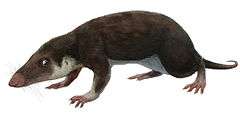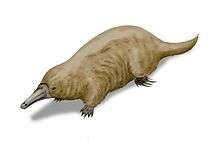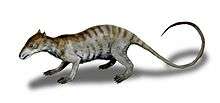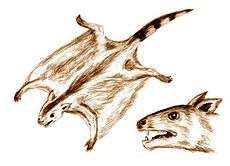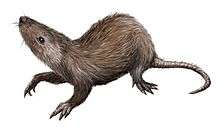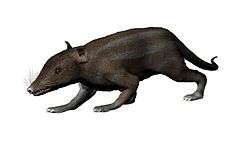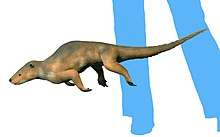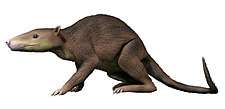Gondwanatheria
Gondwanatheria is an extinct group of Mammaliaformes that lived in the Southern Hemisphere, including Antarctica, during the Upper Cretaceous through the Miocene (and possibly much earlier, if Allostaffia is a member of this group[3]). Until recently, they were known only from isolated teeth, a few lower jaws, two partial skulls and one complete cranium.[4] Because of this fragmentary knowledge, their placement is not clear.
| Gondwanatheria | |
|---|---|
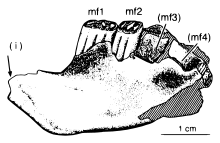 | |
| Mandible of Sudamerica | |
| Scientific classification | |
| Kingdom: | Animalia |
| Phylum: | Chordata |
| Clade: | Therapsida |
| Clade: | Cynodontia |
| Clade: | Mammaliaformes |
| Clade: | †Gondwanatheria Mones, 1987 |
| Subgroups | |
| |
Classification
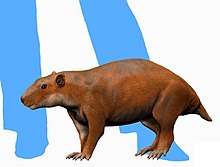
For several decades the affinities of the group were not clear, being first interpreted as early xenarthrans, or "toothless" mammals similar to the modern anteater. A variety of studies have placed them as allotheres related to multituberculates, possibly even true multituberculates, closer to cimolodonts than "plagiaulacidans" are.[1][5][6][7] However, a more recent study recovered them as nested among haramiyidans, rendering them as non-mammalian cynodonts.[8] A more recently described specimen has since recovered them as allotheres closely related to multituberculates,[9] but this was soon after followed by a study recovering them as part of Euharamiyida, remaining inconclusive to whether they belong in crown-group Mammalia.[10]
There are three known families within Gondwanatheria. The family Sudamericidae was named by Scillato-Yané and Pascual in 1984, and includes the vast majority of named taxa. The family Ferugliotheriidae was named by José Bonaparte in 1986, and includes one genus, Ferugliotherium, and possibly a few other forms like Trapalcotherium. Groeberiidae, originally interpreted as paucituberculate marsupials, has since been understood as gondwanatherians, though only the type genus, Groeberia, has been examined as such.[1]

Further fossils have come from India, Madagascar and Antarctica. A possible Ferugliotherium-like species occurs in Maastrichtian deposits of Mexico, extending the clade to North America.[11]
The Miocene (Colhuehuapian) genus Patagonia is the youngest known representative.[1]
Biology
Gondwanatheres known from cranial remains almost universally have deep, robust snouts, as befitting their specialised herbivorous lifestyle. Groeberia and Vintana both possess bizarre jugal flanges similar to those of xenarthrans like ground sloths, though they had a palinal (front-to-back) chewing method as in most allotheres and unlike almost any therian.[1][5] Most gondwanatheres are specialised grazers, even being among the first mammals to have specialised for grass-eating long before any therians did, with the exceptions of Groeberidae and Ferugliotheriidae, which lack hypsodont teeth and therefore had more generalistic herbivorous habits.
An articulated specimen found in the Maevarano Formation offers insight to the postcranial skeleton of these animals. Among the bizarre and unique features are a mediolaterally compressed and antero-posteriorly bowed tibia, a double trochlea on the astragalus, a fully developed humeral trochlea, and an unusually high number of trunk vertebrae. The new taxon has at least 19 rib-bearing (thoracic) and 11 non-rib-bearing (lumbar) vertebrae. Aside from these derived features, the Malagasy mammal has a mosaic pectoral girdle morphology: the procoracoid is lost, the coracoid is extremely well developed (into an enlarged process that contributes to half of the glenoid fossa), the interclavicle is small, and the sternoclavicular joint appears mobile. A ventrally-facing glenoid and the well-developed humeral trochlea suggest a relatively parasagittal posture for the forelimbs. Remarkable features of the hind limb and pelvic girdle include a large obturator foramen similar in size to that of therians, a large parafibula, and the presence of an epipubic bone.[12]
The fully described animal, now named Adalatherium hui, is a comparatively large sized mammal, compared in size to a large cat. It has more erect limbs than other allotheres.[9]
Taxonomy
Order †Gondwanatheria[13][14] McKenna 1971 [Gondwanatheroidea Krause & Bonaparte 1993]
- ?†Allostaffia[3]
- †Adalatherium
- ?Family †Groeberiidae Patterson, 1952
- †Groeberia minoprioi Ryan Patterson, 1952
- †Groeberia pattersoni G. G. Simpson, 1970
- Family †Ferugliotheriidae Bonaparte 1986
- †Ferugliotherium windhauseni Bonaparte 1986a [Vucetichia Bonaparte 1990; Vucetichia gracilis Bonaparte 1990]
- †Trapalcotherium matuastensis Rougier et al. 2008
- ? †Magallanodon baikashkenke Goin et al. 2020
- Family †Sudamericidae Scillato-Yané & Pascual 1984 [Gondwanatheridae Bonaparte 1986]
- †Greniodon sylvanicum Goin et al. 2012
- †Vintana sertichi Krause et al. 2014
- †Dakshina jederi Wilson, Das Sarama & Anantharaman 2007
- †Gondwanatherium patagonicum Bonaparte 1986
- †Sudamerica ameghinoi Scillato-Yané & Pascual 1984
- †Lavanify miolaka Krause et al. 1997
- †Bharattherium bonapartei Prasad et al. 2007
- †Patagonia peregrina Pascual & Carlini 1987
- †Galulatherium O'Connor et al. 2019
References
- Chimento, Nicolás R.; Agnolin, Federico L.; Novas, Fernando E. (22 April 2014). "The bizarre 'metatherians' Groeberia and Patagonia, late surviving members of gondwanatherian mammals". Historical Biology. 27 (5): 603–623. doi:10.1080/08912963.2014.903945.
- Francisco J. Goin, Marcelo F. Tejedor, Laura Chornogubsky, Guillermo M. López, Javier N. Gelfo, Mariano Bond, Michael O. Woodburne, Yamila Gurovich, Marcelo Reguero (2012). "Persistence of a Mesozoic, non-therian mammalian lineage (Gondwanatheria) in the mid-Paleogene of Patagonia". Naturwissenschaften. 99 (6): 449–463. Bibcode:2012NW.....99..449G. doi:10.1007/s00114-012-0919-z. PMID 22584426.CS1 maint: uses authors parameter (link)
- Chimento, Nicolas; Agnolin, Federico; Martinelli, Agustin (May 2016). "Mesozoic Mammals from South America: Implications for understanding early mammalian faunas from Gondwana". Historia Evolutiva y Paleobiogeográfica de los Vertebrados de América del Sur. pp. 199–209.
- Kraus, David W. (2014). Vintana Sertichi (Mammalia, Gondwanatheria) from the Late Cretaceous of Madagascar. [Lincoln, NE]: Society of Vertebrate Paleontology. pp. 1–2.
- Krause, David W.; Hoffmann, Simone; Wible, John R.; Kirk, E. Christopher; Schultz, Julia A.; von Koenigswald, Wighart; Groenke, Joseph R.; Rossie, James B.; O’Connor, Patrick M.; Seiffert, Erik R.; Dumont, Elizabeth R.; Holloway, Waymon L.; Rogers, Raymond R.; Rahantarisoa, Lydia J.; Kemp, Addison D.; Andriamialison, Haingoson (5 November 2014). "First cranial remains of a gondwanatherian mammal reveal remarkable mosaicism". Nature. 515 (7528): 512–517. Bibcode:2014Natur.515..512K. doi:10.1038/nature13922. PMID 25383528.
- "Fossil From Dinosaur Era Reveals Big Mammal With Super Senses". National Geographic News. 5 November 2014.
- Wilford, John Noble (November 5, 2014). "Fossil's Unusual Size and Location Offer Clues in Evolution of Mammals". New York Times. Retrieved November 6, 2014.
- Huttenlocker, Adam K.; Grossnickle, David M.; Kirkland, James I.; Schultz, Julia A.; Luo, Zhe-Xi (23 May 2018). "Late-surviving stem mammal links the lowermost Cretaceous of North America and Gondwana". Nature. 558 (7708): 108–112. Bibcode:2018Natur.558..108H. doi:10.1038/s41586-018-0126-y. PMID 29795343.
- Krause, David W.; Hoffmann, Simone; Hu, Yaoming; Wible, John R.; Rougier, Guillermo W.; Kirk, E. Christopher; Groenke, Joseph R.; Rogers, Raymond R.; Rossie, James B.; Schultz, Julia A.; Evans, Alistair R.; von Koenigswald, Wighart; Rahantarisoa, Lydia J. (29 April 2020). "Skeleton of a Cretaceous mammal from Madagascar reflects long-term insularity". Nature: 1–7. doi:10.1038/s41586-020-2234-8.
- https://royalsocietypublishing.org/doi/10.1098/rspb.2020.0943
- SVP 2015
- HOFFMANN, Simone, THE FIRST POSTCRANIAL REMAINS OF A GONDWANATHERIAN MAMMAL, October 2016
- Mikko's Phylogeny Archive Haaramo, Mikko (2007). "†Gondwanatheria – gondwanatheres". Retrieved 30 December 2015.
- Paleofile.com (net, info) "Archived copy". Archived from the original on 2016-01-11. Retrieved 2015-12-30.CS1 maint: archived copy as title (link). "Taxonomic lists- Mammals". Retrieved 30 December 2015.
External links
| Wikimedia Commons has media related to Gondwanatheria. |
| Wikispecies has information related to Gondwanatheria |
